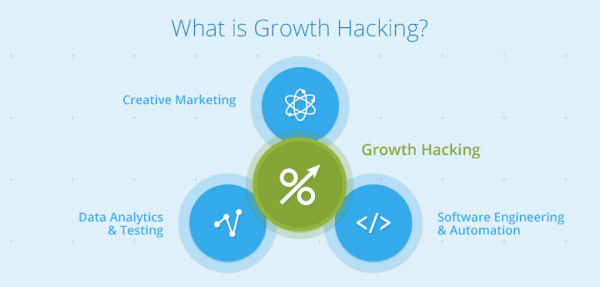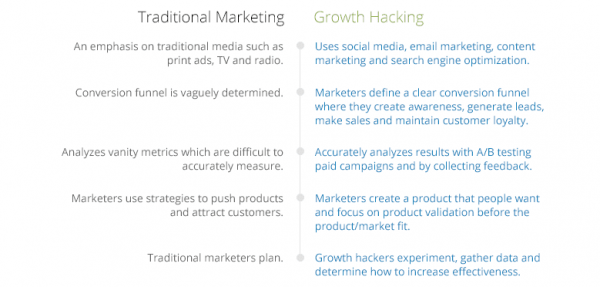What is growth hacking?
Growth hacking is a technique all marketers should consider using. Companies like Facebook, Twitter and LinkedIn have used growth hacking to gain incredible numbers of users and loyal communities. Originally, growth hacking helped lean start-ups increase profits in relatively short periods of time. The benefits however, can also increase the effectiveness of larger, well-funded marketing campaigns.
Growth hacking has been used for software, blogs, retail products and more recently for apps. The company AppVirality created a dashboard for apps that allows developers to run A/B testing, measure analytics on traffic from each tool, and tracks conversions and revenue. According to TechCrunch, AppVirality was successfully used by an Indian startup that received $465,000 more seed funding.
The picture below shows the three major components of growth hacking:

What’s the difference between growth hacking and traditional marketing?
Traditional marketing focuses on getting customers to like your product, and growth hacking is making a product that your customers like.
The basic fundamentals of growth hacking are:
- Optimizing websites for better user experience to boost conversion rates.
- Strong social media presence on relevant channels.
- User-acquisition strategy which includes content marketing and SEO.
- A/B testing landing pages for increased conversion rates.
- Tracking and measuring analytics.
Growth hacking is perfect for start-ups, as it uses online marketing to help them acquire a significant number of users. This is shown in the image above.
A growth hacker develops the strategies that lead to a company’s viral growth. An effective growth hacker uses tools that can work for any size or type of company. These tools include:
- Viral acquisition: Tactics at the beginning of the conversion funnel to maintain customer loyalty and gain new customers through positive word of mouth.
- Paid acquisition: Paid promotions such as Facebook ads, Twitter ads, mobile ads, pay-per-click advertising and affiliate marketing. These help companies reach a wider audience and boost conversions in the target segment.
- Content marketing: This is the root of social media strategy and includes blogs, slideshares, whitepapers, ebooks, infographics and videos. They help companies boost conversion rates by solving customers’ problems.
- Email marketing: Communicating with users about a brand via email. This increases sales and transforms followers into loyal customers by keeping them engaged.
- Search engine optimization: Successful marketers know how to use SEO effectively. They place high in search rankings by using the keywords for which their target audience is searching, and by using short and long-tail keywords in the right way.
- A/B testing and analytics: A/B testing paid campaigns improve conversion rates by analyzing which techniques work best.
The picture below highlights the major differences between traditional marketing and growth hacking:

Don’t forget to share this article


